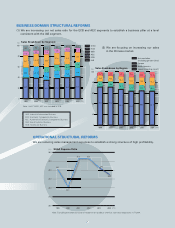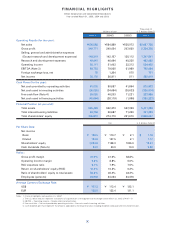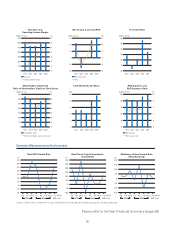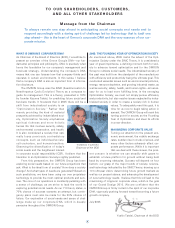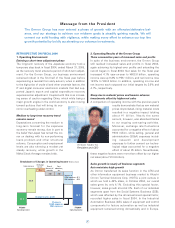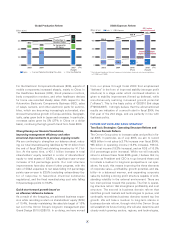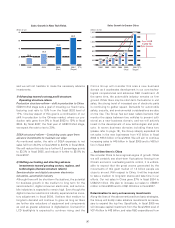Omron 2005 Annual Report Download - page 15
Download and view the complete annual report
Please find page 15 of the 2005 Omron annual report below. You can navigate through the pages in the report by either clicking on the pages listed below, or by using the keyword search tool below to find specific information within the annual report.
13
GOALS FOR FISCAL 2007 AND OUR PROGRESS
The main goal of GD2010 2nd Stage is not merely the
achievement of period income; rather, the essential objec-
tive is to “balance growth and earnings.” The reason we
are boldly aiming to double business value, which we
relate to future growth potential, is to come together as a
group and build an operating base that has high future
growth potential. Our minimum goals to achieve this dou-
bling of business value are to establish new business
domains that can be expected to grow by an average of
20% or greater, in principle over a 5 to 10-year growth
cycle, and to secure ¥68 billion or greater in sales by fiscal
2007 (a ¥50 billion increase in sales over fiscal 2003). As for
progress made thus far, our sales results for new business
domains in fiscal 2004 were ¥28.8 billion, 60% higher than
in fiscal 2003. Our technology-driven growth strategy con-
tinues to advance steadily, with expectations to secure
50% or greater growth in fiscal 2005.
Sales Growth in New Tech Fields
2004 2005
(Plan)
2003 2007
(Target)
60
90
30
0
(Billions of yen)
28.8
45.0
QLM
LCD BL
MEMS
AEC
Others
QLM
LCD BL
180
¥50b
increase
from
FY2003
GD2010
2nd Stage
Ta rget: ¥68b
Others
MEMS
AEC
Others
18.0
AEC (Automotive Electronic Components):
Laser radars for automobiles
MEMS: MEMS Sensors, etc.
LCD BL: Liquid crystal backlight
QLM: Automated Optical Inspection
Machines, etc
SPECIFIC EXAMPLES OF NEW BUSINESS DOMAINS
(1) Liquid crystal display devices—making great strides in brightness improvement and low power consumption
Liquid crystal displays project images not through an emission of light
from liquid crystals themselves, but by shining light onto a liquid crys-
tal panel. Through our proprietary technology, the Omron Group
developed the Micro-Lens Array (MLA), which combines several mil-
lion refined micro-sized lenses on a single board. With the MLA,
which refracts light that usually disperses in all directions in a single
direction, we have developed and are manufacturing and marketing
an epoch-making LCD backlight unit for use in cellular phones and
digital cameras. The unit maximizes the efficiency of light utilization
and has brightness, compactness, and low power consumption prop-
erties. Until now, liquid crystal display used in mobile phones have
employed two or more LEDs, which are the light sources behind the
liquid crystals. However, the backlight unit manufactured by Omron
realizes equivalent brightness while using only one LED. Moreover,
we are evolving the MLA, and through double prism technology
(which adds a sub-prism to eliminate the need for sheets) and nano-
prism technology (which increases the transparency of the optical
waveguide), we are developing a reversible light that combines the
liquid crystal panel’s backlight and front light into one light.
(2) OKAO Vision—machines that recognize human faces
The Omron Group is developing OKAO Vision, a technology for discerning human faces by
detecting distinctive information from images (dot aggregations) obtained by sensors. OKAO
Vision is comprised of five elemental technologies: (1) detection of the face; (2) detection of parts
of the face; (3) facial recognition; (4) inference of gender, age, and race; and (5) optimal enhance-
ment of facial images. Technology that extracts only the information necessary for discernment
and inference and uses efficient algorithms makes possible high-speed detection using small,
mobile equipment. Facial image enhancement functions* are already in use by home-use ink-jet
printers, but as needs for preventing misuse of cellular phones with fund transfer functions rise,
the use of facial recognition functions as a new security measure for cellular phones is gaining
attention. There has also been ongoing development of devices that enable vehicles to ensure
safety by detecting a driver’s condition of fatigue and the likelihood of a driver falling asleep at the wheel. In such ways, the applica-
tion domain of facial recognition technology is expanding to include a wide range of areas.
*Facial image enhancement functions: Functions to enhance skin color and so forth at the time of printing by the detection of a “face” from an image obtained by a digital
camera, etc.
2 backlights
Old system Reversible light
Reversible light
Main liquid
crystal display
Main side Sub side Main side
Backlight
Sub side
Front light
Sub liquid
crystal display
Liquid crystal
display
MLA Technology
An array of micro-sized
lenses.
Sub side (front light) Main side (backlight)
Detection of the face Facial recognition
Detection of parts
of the face
Gender, age, and
race inference
Optimal enhancement of facial image
Ms. OKAO
Female, 20s


